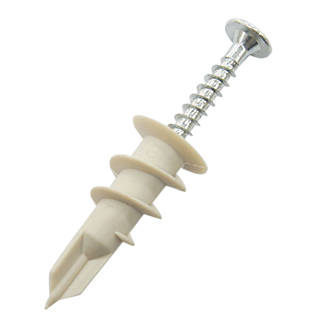We’d like to remind Forumites to please avoid political debate on the Forum.
This is to keep it a safe and useful space for MoneySaving discussions. Threads that are – or become – political in nature may be removed in line with the Forum’s rules. Thank you for your understanding.
📨 Have you signed up to the Forum's new Email Digest yet? Get a selection of trending threads sent straight to your inbox daily, weekly or monthly!
Drill bit and rawlpugs size
retiredandskint
Posts: 852 Forumite






Apologies if this seems a daft question but how do you work out the size of the rawlplug and drill bit needed.
0
Comments
-
Do you know what size of screw you need? If so, Google "rawl plug size" to see a number of conversion charts, diagrams, etc. You can convert the gauge or diameter of your screw to the correct size of rawlplug. You can get plugs of fixed length or you can buy strips that you can cut to length if you've got a particularly long screw.
Edited to add: the size of plug will determine the size of drill bit to use. Again, there are lots of charts available on the web. Most drill bit sets have the gauge and diameter of the bits on the box/packet.0 -
5.5mm bit, red plug, 8 gauge screw.0
-
It'll tell you on the tab the plugs are attached to or on the box if loose.0
-
Thanks for all your answers.
The job I'm trying to do is hang the Dyson cordless vacuum holder to the wall. The wall is plasterboard. I was just going to find two flat headed screws that fit in the holder screw holes.0 -
retiredandskint wrote: »Apologies if this seems a daft question but how do you work out the size of the rawlplug and drill bit needed.
As others have said, the plugs should tell you want size drill to use.
Unless you are fixing into something very hard then I tend to go one drill size down from the suggested one. E.g. brown plugs often state 7mm, but I use 6.0 or 6.5mm.
If the wall is hard then I'd drill at 6.0 and then very carefully expand the outer part of the hole with a 7mm drill. The plugs are usually tapered and it is only the outer 5mm or so which fits snugly into a parallel drilled hole.
The biggest mistake for beginners is to use the full size drill first and for it to 'wander' and wobble leaving the outer part of the hole oversize and providing no support or grip.
Always drill undersize first and expand if required for the job."In the future, everyone will be rich for 15 minutes"0 -
retiredandskint wrote: »The wall is plasterboard.
In which case you need to use special plasterboard fixings. Check on Screwfix or Toolstation for examples.
Edit: And personally I use standard twist drills (of the type used for metal or plastic) for drilling in plasterboard. It isn't healthy for the drillbit, but ensures a much more accurate hole. Drillbits are so cheap these days it doesn't matter if you wear them out by drilling plasterboard."In the future, everyone will be rich for 15 minutes"0 -
I'd start with a yellow plug & 5mm drill bit i find this is strong enough for most things around the house, if it's really heavy use a red plug & 6mm drill bit, I've never had to use a brown plug & 7mm drill bit yet, and up to now nothing has every fallen down.ANURADHA KOIRALA ??? go on throw it in google.0
-
I have a pack of this style for lightweight plasterboard jobs
https://www.screwfix.com/p/easyfix-self-drill-plasterboard-fixings-nylon-32mm-100-pack/3685h
there are various versions/price points.
there is this type but I find they can spin. 0
0 -
They look just the job and it'll save me having to go through Mr Retiree's boxes of screws
 0
0
This discussion has been closed.
Confirm your email address to Create Threads and Reply

Categories
- All Categories
- 352.9K Banking & Borrowing
- 253.9K Reduce Debt & Boost Income
- 454.7K Spending & Discounts
- 246K Work, Benefits & Business
- 602K Mortgages, Homes & Bills
- 177.8K Life & Family
- 259.9K Travel & Transport
- 1.5M Hobbies & Leisure
- 16K Discuss & Feedback
- 37.7K Read-Only Boards




